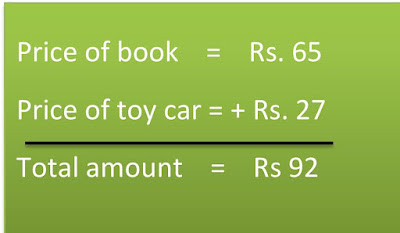LESSON PLAN OF SOLVE REAL LIFE PROBLEM INVOLVING ADDITION & SUBTRACTION
LESSON PLANNING OF SOLVE REAL LIFE PROBLEM
INVOLVING ADDITION & SUBTRACTION
Subject Mathematics
Grade 2nd
Students` Learning Outcomes
- Solve real life problems (using Pakistani currency as well) involving addition, & Subtraction
Information for Teachers
- Have the concept of “addenda” and “sum”.
- “Addenda” those quantities, to which we want to add, is plural for addendum.
- “Sum” is the result after adding quantities.
- By doing addition when things become more than ‘10’ in unit place or tens place we take ‘1’ as carry to tens or hundreds place respectively.
- When doing sums regarding subtraction if in unit place or tens of ‘minuend’ digits are smaller than ‘subtrahend’ take ‘1’ as borrow from tens or hundreds place digits and add ‘10’ in place of ‘1’ in unit and tens digits.
- While teaching the lesson, the teacher should also consult textbook at all steps where and when applicable.
Material / Resources
Writing board, chalk / marker, duster, fake
currency notes (of different values) (4 sets), match sticks / stones
Introduction
Activity 1
- Tell the story:
- Give the students some time to think and ask.
- What is the price of the sweet? (Rs. 100)
- What other thing did he buy? (Juice)
- What is the price of the juice? (Rs.120)
- How will you find the total cost? (By adding)
- Ask them to add and check their work.
Development
Activity 1
- Tell the story to the students.
- Help the students to understand the story and ask following questions.
- How much money had Jasmine? (Rs.100)
- What did she buy? ( a book and a toy car)
- What was the price of a book? (Rs.65)
- Ask one student to write this on the board.
- What was the price of the toy car? (Rs.27)
- How will we find the total amount she spent? (will add price of book and toy car)
- Ask another student to write Rs.27 under the price of the book on the board as;
- Ask from the students.
- How much money she spent? (Rs.92)
- Now what we have to find? (Money left)
- How will we find it? (By subtraction)
- Ask one students to write on the board.
- Total money jasmine had = Rs 100
- Total money she spent = Rs 92
- Amount left by Jasmine = Rs 8
- Help them to solve with the help of notes (by changing Rs.100 (note) into Rs.10 (notes) and ten rupee note into ten coins of Rs.1)
- How much amount Jasmine has now?
Activity 2
- Ask the two students to arrange some items or toys in class and perform a role of a shopkeeper.
- Put the price tags on each item (prices should be less than Rs.50)
- Provide the different fake notes of 2, 5, and 10 (of 100) to the remaining at least 3 students.
- Ask them to buy two toys.
- Calculate the price of two toys (loudly) and give money to shopkeeper.
- Also tell how much they are left with?
- They can use the board to add the price of two items. Check the remaining amount by subtracting prices of items from Rs.100.
- In the same way each student will be involved in addition and subtraction of money.
Sum up / Conclusion
- We need money to buy things.
- We can add or subtract money as per our need.
- More things have more cost.
- Addition and subtraction of money is same as other numeral addition and subtraction.
Assessment
- Ask the following questions:
Follow up
- Ask them to convert following mathematical statement into story and ask them to write story on chart paper and solve them.
- As the students to solve the questions given
in their textbook

















Comments
Post a Comment